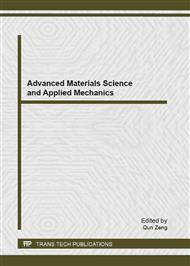[1]
R.N. Jacobs, L.A. Almeida, J. Markunas, J. Pellegrino, M. Groenert, M. Jaime-Vasquez, N. Mahadik, C. Andrews, S.B. Qadri, T. Lee, and M. Kim: Comparative study of thermal mismatch effects in CdTe/Si, CdTe/Ge, and CdTe/GaAs composite structures: CS MANTECH Conference, Chicago, Illinois, USA (2008)
DOI: 10.1016/j.jcrysgro.2008.02.029
Google Scholar
[2]
J. Suela, I. R.B. Ribeiro, S.O. Ferreira, A. Malachias, G.N. Fontes, L.A. Montoro, and A. J. Ramirez: J. Appl. Phys. Vol. 107, (2010), P. 064305-1.
Google Scholar
[3]
E. C. Garnett and P. Yang: J. Am. Chem. Soc. Vol. 130 (2008), 9224.
Google Scholar
[4]
M.H. Ehsan, H.R. Dizaji, M.H. Mirha j: Digest Journal of Nanomaterials and Biostructures Vol. 7 (2012) P. 629.
Google Scholar
[5]
W.A. Pinheiro, V.D. Falcão, L. R. de Oliveira Cruz, C.L. Ferreira: Materials Research Vol. 91 (2006), P. 47.
Google Scholar
[6]
K. Zanio: Semiconductor and Semimetal volume 13 (Academic Press, USA 1978).
Google Scholar
[7]
S. M. Sze: Physics of Semiconductor Devices 3rd edition (John Wiley and Sons, USA 2007).
Google Scholar
[8]
W. F. Mohammad: Circuits and Systems Vol. 4 (2012), P. 42.
Google Scholar
[9]
M. Morgan and K. Board: An Introduction to Semiconductor Microtechnology (John Wiley and Sons Inc., USA 1991).
Google Scholar
[10]
S. H. Demtsu: Impact of Back–Contact Materials on Performance and Stability of CdS/CdTe Solar Cells, PhD thesis, Colorado State University, Fort Collins, Colorado, USA (2006).
Google Scholar
[11]
A.A. Alnajjar, M.F.A. Alias, R.A. Almatuk and A.A. Al-Douri: Renewable Energy Vol. 34, 21 (2009), P. 2160.
DOI: 10.1016/j.renene.2009.01.008
Google Scholar
[12]
M.A. Green: Solar Cells; Operating Principles, Technology and System Applications (Prince-Hall Inc, USA 1982).
Google Scholar
[13]
F. Buch, A.L. Fahrenbruch and R.H. Bube: Journal of Applied Physics Vol. 48 (1977), P. 1596.
Google Scholar
[14]
A.G. Milnes and D.L. Feucht: Hetrojunctions and Metal-Semiconductor Junctions (Academic press, UK 1972).
Google Scholar
[15]
M. Niraula, K. Yasuda, A. Watanabe, Y. Kai, H. Ichihashi, W. Yamada, H. Oka, T.Yoneyama, H . Nakashima, T. Nakanishi, K. Matsumoto, D. Katoh and Y Agata: IEEE Nuclear Science Vol. 56 (2009), P. 836.
DOI: 10.1109/tns.2008.2010256
Google Scholar
[16]
M. Niraula, K. Yasuda, K. Noda, K. Nakamura, I. Shingu, M. Yokota, M. Omura, S. Minoura, H. 0O hashi,v R. Tanaka and Y. Agata: IEEE Nuclear Science Symposium Conference Record (2006).
DOI: 10.1109/nssmic.2006.353816
Google Scholar


